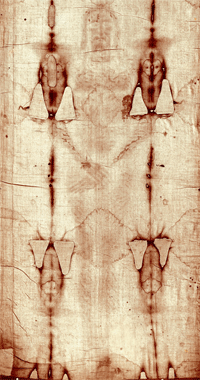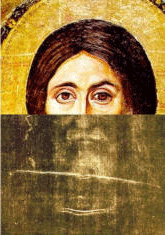
From April 10 through May 23, 2010, millions of people streamed into the city of Turin (Torino) in northern Italy to catch a glimpse of the famous Shroud of Turin. This brief, much anticipated occasion, was only the sixth time in the last hundred years that the shroud has been available for pilgrims to view.
As Pope Benedict said during his visit to Turin on May 2nd, the shroud "is a burial cloth that wrapped the body of a man who was crucified in a way corresponding completely to what the Gospels tell us of Jesus."
While the Catholic Church does not have an official position on whether or not the shroud belonged to Jesus, the Pope continued by saying, "The shroud is an icon written with blood: the blood of a man flagellated, crowned with thorns, crucified and wounded on his right side."
The face that looks out at us could be the face of Christ. It is an awe-inspiring and humbling thought.
Scientists and researchers continue to reveal fascinating new discoveries with each passing year. Here are some intriguing details you may have missed hearing about!
|
The Shroud in Artwork
When the Pantocrator Icon is overlaid on the face from the Shroud of Turin, the dimensions of the two images are similar and the facial features line up. Each image has large eyes and long hair parted down the center. The artists used what they had learned from observing the shroud to create more realistic and life-like images of Our Lord in their icons. |
Restoration and Studies
In 2002, the shroud underwent a restoration process in order to help preserve the image. Burned pieces from a fire in 1532 were removed, patches done in the past to repair holes were also removed. A lining placed on the back of the shroud in 1534 was replaced. The shroud is no longer kept rolled up, but spread flat in a specially designed computerized case to ensure a stable environment around the shroud.
Many studies have been conducted on the shroud to determine its authenticity, who it belonged to, how it was made, and when it was made. As technology has improved, more and more information has been extracted from this mesmerizing image. While the shroud was being restored, the cloth was digitally scanned and high definition pictures were taken to aid researchers.
A study completed last year by Vatican researcher Barbara Frale, used computer-enhanced images of the shroud to study the area around the face. She was taking a closer look at letters originally discovered on the shroud in1978. Her analysis pieced together letters and words in Greek, Latin and Aramaic that told a story. In the time of Jesus, the bodies of those Jews who were executed were usually held for one year in common graves before being given back to the families. Frale believes the words around the face are the contents of the death certificate that would have been glued onto the shroud to help identify the body. She translated the words to say, "In the year 16 of the reign of the Emperor Tiberius Jesus the Nazarene, taken down in the early evening after having been condemned to death by a Roman judge because he was found guilty by a Hebrew authority, is hereby sent for burial with the obligation of being consigned to his family only after one full year" (originally reported by Ariel David, Associated Press).
The Debate
Skeptics of the shroud have many theories to say that it is a forgery. Some say it was painted in the medieval times. Some say it was created by Leonardo da Vinci and is a self portrait, or that it was an early form of photography. However, it was Carbon-14 tests conducted in 1988 that created the greatest cry that the shroud must be a fake. Three tests from three laboratories each concluded that the material of the shroud dated between 1260 and 1390.
Supporters of the authenticity of the shroud point to numerous tests by scientists and experts which seem to prove that it is real. Over the years studies have found samples to contain real human blood, real human muscle tissue, and injuries that are completely in line with those recorded in the Bible during Christ's crucifixion. The debate, and the studies, continues as each side continues to search for a definitive answer.
